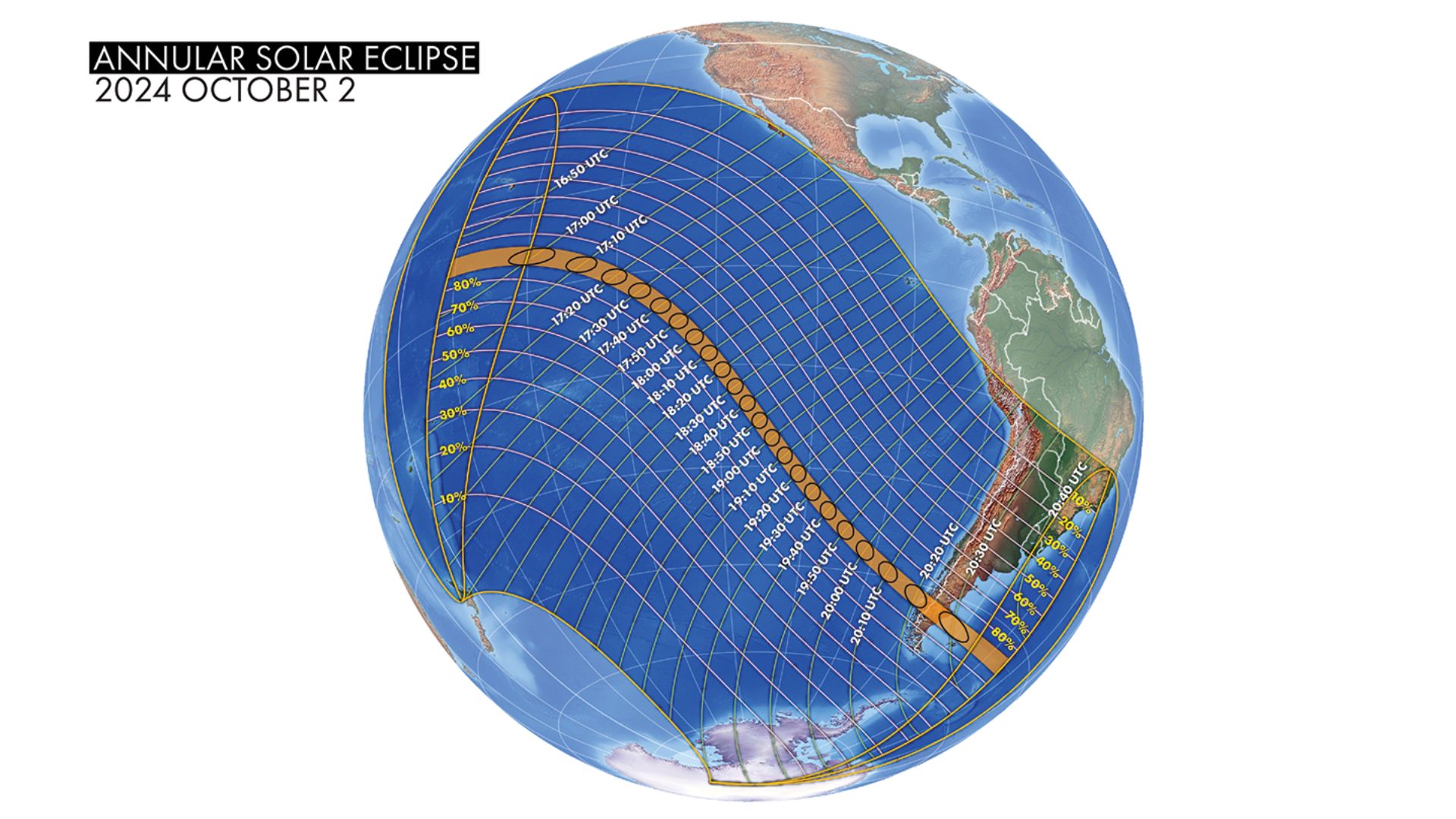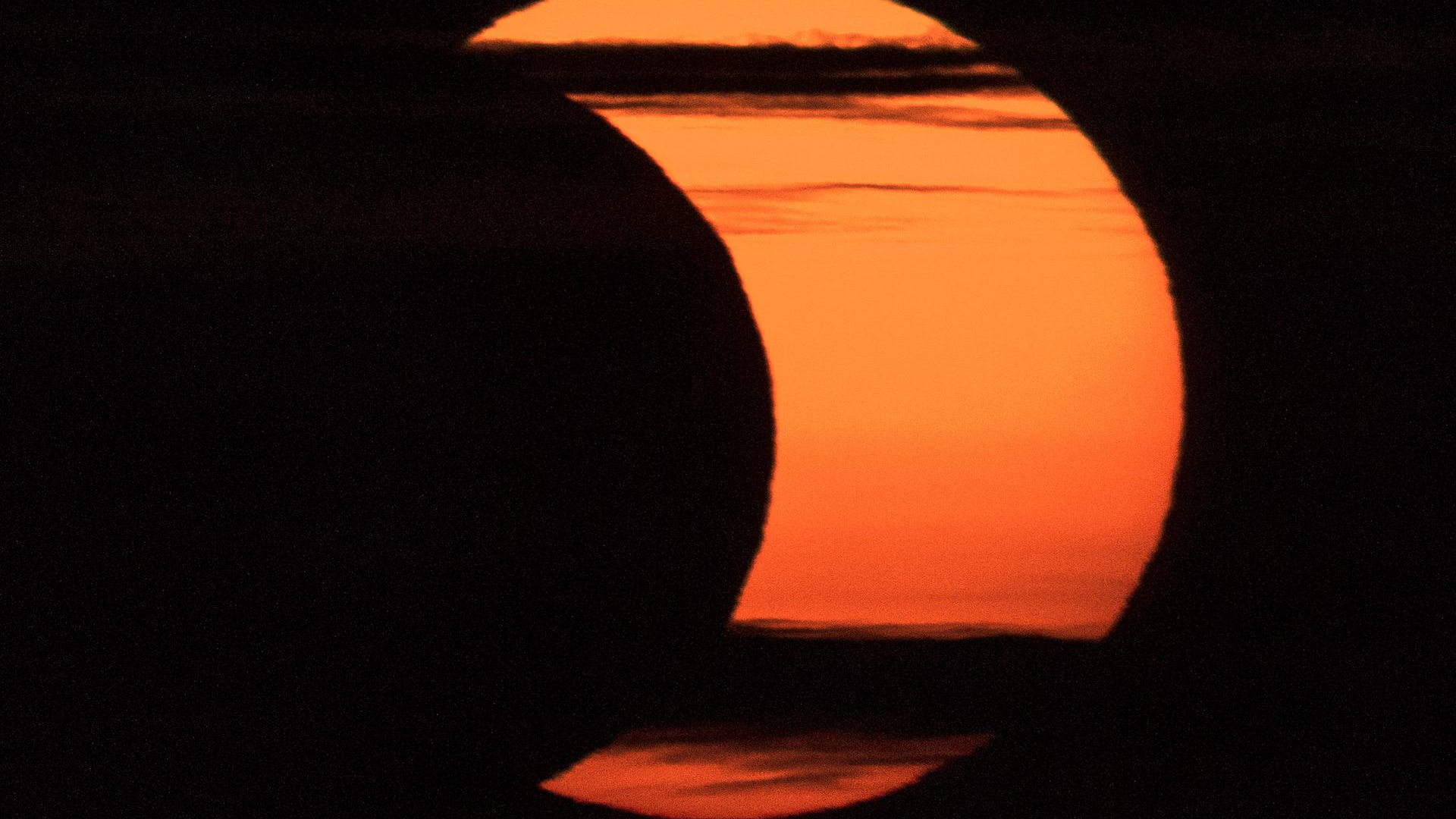Today (Oct. 2), an annular solar eclipse will begin its journey across parts of the Pacific Ocean, southern Chile and southern Argentina.
If you're unable to see the eclipse in person, you can watch the annular solar eclipse online here at Space.com, courtesy of TimeandDate, and follow all the action on our solar eclipse live updates page. The annular phase of the eclipse will first be visible from Earth at 12:50 p.m. EDT (1650 GMT); however, the best time to watch livestreams will be from 3:03 to 3:09 p.m. EDT (1903 to 1909 GMT), when the ring of fire will be seen for up to 6 minutes and 11 seconds from Easter Island (also known as Rapa Nui).
During a solar eclipse, the moon passes between the sun and Earth, casting a shadow upon our planet. The moon's orbit around Earth is slightly elliptical: Sometimes it's farther from Earth, and sometimes it's closer. During an annular or "ring of fire" eclipse, the moon is relatively far from Earth and does not fully cover the sun's disk like we see during a total solar eclipse. Instead, it leaves a distinct ring of light in the sky — the "ring of fire."

If you want to be ready for the next solar eclipse, or safely observe the sun, you'll need proper solar eclipse glasses. This 5-pack of Soluna ISO Certified Safe solar eclipse glasses is on sale for $9.99, that's 60% off, at Amazon.
According to TimeandDate, only about 175,000 people live within the path of annularity for today's eclipse — a route between 165 and 206 miles (265 to 331 kilometers) wide. Those lucky enough to be situated within that band will experience a "ring of fire;" those outside it but still relatively close enough will see a partial solar eclipse, in which the moon appears to take a "bite" out of the sun.
Where is it visible?

Here are some notable locations that will experience the annular solar eclipse.
- Rapa Nui/Easter Island, Chile (5 minutes, 38 seconds to 6 minutes, 12 seconds of annularity starting at 14:03 EAST, 67 degrees above North)
- Cochrane, Chile (5 minutes, 40 seconds of annularity starting at 17:21 CLST, 26 degrees above NNW)
- Perito Moreno National Park, Argentina (6 minutes, 17 seconds of annularity starting at 17:21 ART, 25 degrees above NNW)
- Puerto Deseado, Argentina (3 minutes, 22 seconds of annularity starting at 17:27 ART, 20 degrees above NNW)
- Puerto San Julian, Argentina (5 minutes, 12 seconds of annularity starting at 17:24 ART, 21 degrees above NNW)
Here is a list of major cities or other prominent locations that will experience a partial solar eclipse today, along with the percentage coverage of the sun.
- Galapagos Islands (1%)
- La Paz, Bolivia (1%)
- Rio de Janeiro, Brazil (9%)
- São Paulo, Brazil (10%)
- Buenos Aires, Argentina (42%)
- Montevideo, Uruguay (42%)
- Santiago, Chile (44%)
- Villarrica, Chile (63%)
- El Calafate, Argentina (83%)
- Falkland Islands (84%)
- South Georgia Island (76%)
- Punta Arenas, Chile (75%)
- Ushuaia, Argentina (72%)
- Elephant Island (56%)
- Port Lockroy, Antarctica (44%)

How to view the solar eclipse
REMEMBER to NEVER look directly at the sun without safety equipment. You'll need to use solar filters to safely view this eclipse; whether you're going to see the "ring of fire" or a partial solar eclipse, the dangers are the same. Observers will need to wear solar eclipse glasses, and cameras, telescopes and binoculars must have solar filters placed in front of their lenses at all times. Our how to observe the sun safely guide tells you everything you need to know about safe solar observations.
Don't forget: You can always watch the annular solar eclipse online here on Space.com, courtesy of TimeandDate.
Editor's Note: If you get a great photo of the solar eclipse and would like to share it with Space.com's readers, send your photo(s), comments, and your name and location to spacephotos@space.com.







